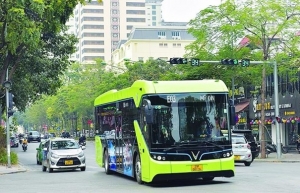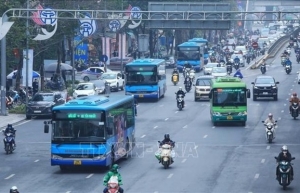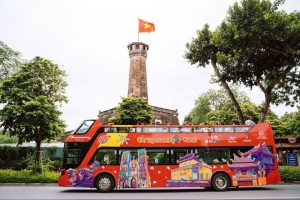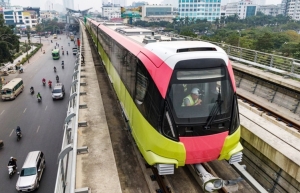Hanoi approves ambitious green bus plan
The plan states that Hanoi aims to have half of its bus fleet electric and the other half running on liquefied natural gas or compressed natural gas (CNG) by 2026-2030, with an estimated budget of VND51 trillion ($2.1 billion). By 2035, the goal is for all buses in Hanoi to be electric.
Hanoi’s current proportion of green energy buses is only about 13.6 per cent. Of the 2,034 subsidised buses, only 277 use clean energy, including 139 CNG buses and 138 electric buses. VinBus is the only company using large-capacity electric buses that it manufactures itself.
|
Speaking to local media, Dr Ha Thanh Tung from the University of Transport and Communications spoke about the three major challenges to implementing the green bus transition plan.
"The first challenge is investment capital. The price of an electric bus is about 3–4 times that of a diesel bus with the same capacity. Similarly, the price of a CNG bus is about twice that of a diesel bus. The battery of an electric bus accounts for about 40-50 per cent of the vehicle’s value and will degrade after 4–5 years of use. The investment in charging stations, transformer systems, power supply, and control systems is also costly," said Tung.
Tung continued, "Secondly, infrastructure for electric buses, especially the charging station network, is limited. Meeting the set timeline requires 3–5 years to upgrade the electrical system and charging stations."
"Thirdly, authorities still lack mechanisms to guide businesses and investors in socialising investments for green energy infrastructure to support the transition to green buses," he added.
Speaking to VOV, the Vietnamese national radio broadcaster, associate professor Dam Hoang Phuc, director of the Automotive Engineering Training Programme at Hanoi University of Science and Technology, stated, "Hanoi needs to assess the feasibility and total investment of green energy sources for buses. A report from the US Environmental Protection Agency showed that CNG vehicles still emit pollutants, producing only about 20 per cent less emissions than petrol vehicles. Moreover, a study by the California Air Resources Board found that CNG reduces emissions by only 12-17 per cent compared to diesel."
Hanoi’s green bus conversion plan is an effort to implement the commitment that by 2025, 100 per cent of replacement/new buses in Vietnam will use electricity or green energy, as stated in Decision No.876/QD-TTg in 2022 on the action programme for green energy transition and reduction of carbon and methane emissions in the transport sector.
Speaking to VOV, Dr Tran Dinh Thien, former director of the Vietnam Institute of Economics, said, “Vietnam has made strong green transition commitments to the world, with the net-zero target by 2050 being one of them. Therefore, Hanoi’s choice of vehicles for green transition should aim towards clean, environmentally friendly options. Vietnam needs and must accelerate green transition to achieve its goals. If the transformation isn’t strong enough, Vietnam will struggle to fulfil its commitments, falling behind and being sidelined in the development race.”
 | Hanoi takes moves to develop green transportation Following global trends on green transportation, the capital city of Hanoi has been striving to develop a green transport system. |
 | Hanoi aims to green up bus system ahead of schedule Hanoi is taking steps to complete the “greening up” of local bus services 15 years ahead of the roadmap designed by the Government, which aims to convert buses from using petrol to green energy (electric or CNG) in Hanoi by 2050, according to Vice Chairman of the Hanoi municipal People’s Committee Nguyen Manh Quyen. |
 | Hanoi plans to introduce new city bus route connecting Bat Trang Hanoi’s People’s Committee has revealed plans to introduce a new city tour bus route linking downtown Hanoi with Bat Trang Ceramics Museum this year. |
 | Hanoi ready to open Nhon-Hanoi metro line The elevated section of the Nhon-Hanoi metro line is expected to officially open in July, following more than ten years of construction. |
What the stars mean:
★ Poor ★ ★ Promising ★★★ Good ★★★★ Very good ★★★★★ Exceptional
Related Contents
Latest News
More News
- Heavy industries set for pilot greenhouse gas quotas (December 25, 2025 | 10:00)
- Swedfund invests in MSME growth and climate action in Vietnam (December 19, 2025 | 11:42)
- GreenYellow brings solar energy to light up remote schools in Tuyen Quang province (December 19, 2025 | 08:00)
- Charge+, Grab partner to develop EV charging network in Vietnam (December 18, 2025 | 17:11)
- Linking sci-tech and innovation to Vietnam’s net-zero future (December 18, 2025 | 14:31)
- Driving double-digit growth through green and circular transformation in Vietnam (December 17, 2025 | 09:00)
- Standard Chartered and ACCA deepen collaboration to develop Vietnam’s talent for a sustainable future (December 15, 2025 | 18:18)
- Schaeffler reports strong early output from Dong Nai solar project (December 12, 2025 | 15:16)
- Forestry conference highlights biodiversity and sustainability goals (December 09, 2025 | 13:35)
- Home Credit honoured among top 10 sustainable companies in trade and services (December 09, 2025 | 12:18)


 Tag:
Tag:





















 Mobile Version
Mobile Version